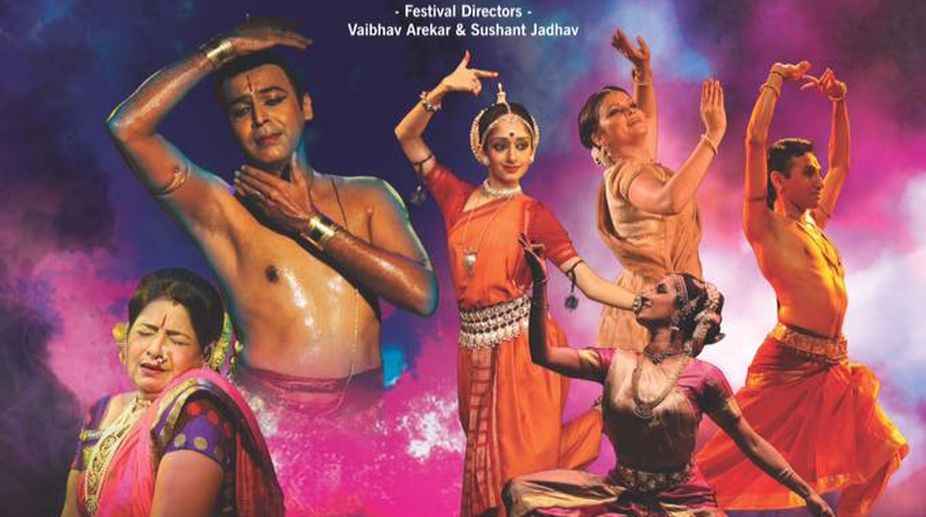Artistic director Vaibhav Arekar and Sushant P Jadav, the co-director of Sankhya Dance Company, Mumbai, celebrated the sixth edition of “Sindhu” in the memory of Arekar’s mother, at Sheila Gopal Auditorium in Bandra, Mumbai recently.
The two-day festival was one-ofits-kind — the theme was “Shringar Rang” or shades of love on day one while “Traditions and Transitions”, showcasing four classical dance styles, was the theme on the second day. “Shringar Rang” included Lavani, a folk dance style of Maharashtra by Sangeet Natak Akademi Awardee Shakuntalabai Nagarkar and group and Bharatanatyam by Vaibhav Arekar and group.
Advertisement
Arekar’s group opened proceedings with Madana or Panchasar coming in and shooting arrows at random to the accompaniment of swaras and chollus in stylised Natyadharmi with larger-than-life representation and movements.
Natyadharmi was contrasted with Lokdharmi Lavani, which is life-oriented and deals with the worldly activities of the people. Here Shakubai belongs to the traditional matriarchal dancing community who has gone through the “ghungroo wearing ritual” and so, according to custom, she cannot marry. She lives life on her own terms, earning her bread by singing and dancing. (Lavani dancers, more often than not, take partners or maliks, who look after them as long as it suits them. Their offsprings are named after the maliks. With the audience, they have a relationship that is based on providing service).
Shakubai and group indulged in a lot of hip shaking, lip biting, heaving of the breasts, naughty smiles, raising of the eyebrows alternately in quick succession and fast twinkling of the eyes, nudging along with dance steps in high tempo followed by Mohanabai’s Andharati Lavani, which spoke of the other woman in her husband’s life.
Lavani dancers perform on sensual issues and erotic subjects as well as religious, political and social issues. Draped in nine yard-saris, bedecked and bejewelled, they wonderfully displayed the raw art of their tamasha theatre. Energetically, the performers sang and danced with the accompaniment of dholak beats, rendering romantic dialogues in the flowing voices of Sangeet Bari artists, showcasing love between man and woman.
Kharaharapriya Varnam, a composition of Dandayudapani Pillai portrays the nayika in love with Nataraja. Her yearning for him was expressed in pristine Bharatanatyam vocabulary using theatre techniques as well. She confides in her sakhi that she cannot bear his absence any longer. Bhakti Sringar was at its height. In the Javali, Yera ra ra by Patnam Subramanya Aiyyar, the nayika again beckons her lover, who is a god, to come to her. Yet in Suga suga nathe suguna, employing a sophisticated and stylised classical Bharatanatyam idiom, the nayika tells Krishna that she has to leave her parental home and go away with her husband whom she married when still a child, but she will always remember him. There is pathos in the love for her god.
On the second day, which dealt with traditions and transitions, Kathaka Gawri Diwakar took lines from Sayyad Mubarak Ali Bilgrami’s song Hari Ho Gati Meri, asking to be merged with the supreme. This search was basically for truth and beauty. Diwakar’s solo production, on the theme of Muslim bhakti poets, was in four parts through Kathak. The piece, which spoke on the eternal resonance of Krishna’s flute, was based on Sayyad Fazlul Hasan’s poetry — a message beckoning to eternal life or the fount of ever increasing knowledge. Shadows of Each Other by Malik Muhammad Jayasi depicted the union of Radha and Krishna. The poet says, “I am immersed in you like a drop of water that dissolves in the ocean.” An extract from Mian Wahid Ali was equally praise worthy. Diwakar presented a splendid piece of work extracted from the choreographic oeuvre of Kathaka Aditi Mangal Das.
Odissi dancer Arushi Mudgal, a Bismillah Khan awardee, performed Aahlad, a pure dance piece in raga Sahnaa, with joyous abandon. The piece was a perfect blend of movement, melody and dance and the music was composed by Pandit Madhup Mudgal. Her dance, Sopaan was all about man’s sojourn through life, which is much like that of the lotus. As the lotus emerges into pristine perfection after its journey through murky waters, an individual goes through the journey of life to arrive at the divine core. Sopaan was an abstract and philosophical piece that depicted the conflict between the transient and the eternal.
In Prana Sangini re choreographed by Guru Kelucharan Mohapatra, Arushi as Radha tells her friend that Krishna came to her disguised as a girl and offered to decorate her feet with alta and etched his name on her feet. It was a very amusing piece rendered with care. She has perfected the Odissi stance to perfection.
Possessed with a svelte physique and a good stage presence, Kuchipudi performer Amrita Lahiri came all the way from Singapore and delighted the audience with Natesha Kautuam in praise of Shiva, choreographed by Guru Vempati Chinna Satyam, followed by Durga Tarangam, choreographed by Jaikishore Mosalikanti, his disciple. Durga, as we all know, had been created by the gods to exterminate Mahisasur, who had been wreaking havoc. In popular parlance, Durga became Mahisasurmardini after killing Mahisasur. The piece ended with Lahiri executing intricate rhythms while standing on a brass plate, which is a trade mark of Kuchipudi. In Balmurali Krishnan’s musical melody in ragam Behag, Lahiri presented the beauty of rhythm in the tillana piece.
In the piece Sakha, talented Bharatanatyam performer Praveen Kumar who proved his mettle right from the start, chose to show the true bond of friendship between Krishna and Arjuna. Kumar called their friendship, “Anupama maitreya”. Unusual chollus in using neat geometric designs, which the style is known for, was loved by dance aficionados. This beautiful lyric was penned by Dr Shatavadhani R Ganesh while the music was by Janhavi Jaiprakash. The next piece, a composition of Mysore Vasudevachar, was about Krishna who is circumspect about the coldness of a gopika towards him.











